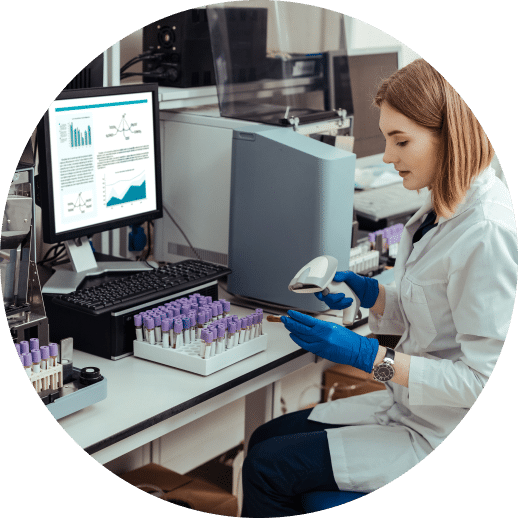Clinical Indication ID & Name
Endocrine neoplasia
Test Group
Endocrinology
Specialties
Test code
R217.1
Test name
N/A
Target genes
Endocrine neoplasms (648)
Test scope
n/a
Test method/ technology
Small panel
Optimal Family Structure
n/a
Eligibility Criteria
Testing of individual (proband) affected with endocrine abnormalities where the individual +/- family history meets one of the following criteria:
1. Multiple endocrine neoplasia type 1 (MEN1). The proband has:
a. Parathyroid multiglandular disease (hyperplasia/ adenomas) (<35 years), OR
b. Any pituitary adenoma or insulinoma (< 20years), OR
c. Pituitary macroadenoma (<30 years), OR
d. ≥2 MEN1-related endocrine abnormalities (any age), OR
e. ≥1 MEN1-related endocrine abnormality and ≥1 MEN1-related non-endocrine tumours (any age),
OR
f. ≥1 MEN1-related endocrine abnormality and a first degree relative has ≥1 MEN1-related endocrine abnormality
MEN1-related endocrine abnormalities include:
- Parathyroid hyperplasia/multiglandular adenomas
- Pituitary tumors
- Endocrine tumors of the gastro-entero-pancreatic (GEP) tract
- Carcinoid tumors
- Adrenocortical tumors
MEN1-related non-endocrine tumours include:
- facial angiofibromas
- collagenomas
- meningioma
2. Familial isolated pituitary adenoma (FIPA)
• Isolated pituitary adenoma developing under the age of 35, with at least one first degree relative with an isolated pituitary adenoma
3. X-linked acrogigantism
• Onset of excess of growth hormone diagnosed by age 20 years in male patients, with increased growth velocity and/or tall stature (height >2 standard deviations above the mean, or >3 standard deviations over mid-parental height)
• If testing on blood is negative and clinical suspicion of this diagnosis is strong, please contact the testing laboratory to discuss sending a fresh frozen tissue or skin biopsy sample to identify a mosaic form of the condition
Where a patient doesn’t meet the stated criteria but there is strong clinical suspicion of a monogenic predisposition to endocrine neoplasia, testing can go ahead after discussion in a specialist MDT meeting
Test code
R217.2
Test name
N/A
Target genes
MEN1;AIP;CDKN1B;CDC73
Test scope
n/a
Test method/ technology
MLPA or equivalent
Optimal Family Structure
n/a
Eligibility Criteria
Testing of individual (proband) affected with endocrine abnormalities where the individual +/- family history meets one of the following criteria:
1. Multiple endocrine neoplasia type 1 (MEN1). The proband has:
a. Parathyroid multiglandular disease (hyperplasia/ adenomas) (<35 years), OR
b. Any pituitary adenoma or insulinoma (< 20years), OR
c. Pituitary macroadenoma (<30 years), OR
d. ≥2 MEN1-related endocrine abnormalities (any age), OR
e. ≥1 MEN1-related endocrine abnormality and ≥1 MEN1-related non-endocrine tumours (any age),
OR
f. ≥1 MEN1-related endocrine abnormality and a first degree relative has ≥1 MEN1-related endocrine abnormality
MEN1-related endocrine abnormalities include:
- Parathyroid hyperplasia/multiglandular adenomas
- Pituitary tumors
- Endocrine tumors of the gastro-entero-pancreatic (GEP) tract
- Carcinoid tumors
- Adrenocortical tumors
MEN1-related non-endocrine tumours include:
- facial angiofibromas
- collagenomas
- meningioma
2. Familial isolated pituitary adenoma (FIPA)
• Isolated pituitary adenoma developing under the age of 35, with at least one first degree relative with an isolated pituitary adenoma
3. X-linked acrogigantism
• Onset of excess of growth hormone diagnosed by age 20 years in male patients, with increased growth velocity and/or tall stature (height >2 standard deviations above the mean, or >3 standard deviations over mid-parental height)
• If testing on blood is negative and clinical suspicion of this diagnosis is strong, please contact the testing laboratory to discuss sending a fresh frozen tissue or skin biopsy sample to identify a mosaic form of the condition
Where a patient doesn’t meet the stated criteria but there is strong clinical suspicion of a monogenic predisposition to endocrine neoplasia, testing can go ahead after discussion in a specialist MDT meeting
Commissioning group
Specialised
Overlapping idications
n/a
Address for samples/request forms
North Thames GLH, Rare & Inherited Disease Genomic Laboratory
Specimen Reception, Level 5 Barclay House, 37 Queen Square,
London WC1N 3BH
Contact with queries
Supporting documents
Rare Disese WGS Clinician pack
Education resources
n/a
Service updates
n/a
Request form download
Consent record
See consent guidance in test request form
Sample requirements
See sample guidance in test request form
